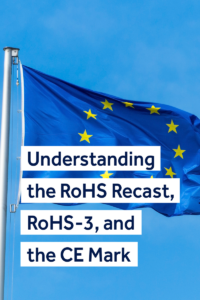EU RoHS
January 16, 2025 | Written by GreenSoft Technology, Inc.
Understanding the RoHS Recast, RoHS-3, and the CE Mark
 A comprehensive guide to RoHS Compliance and CE Marking requirements for electronics manufacturers
A comprehensive guide to RoHS Compliance and CE Marking requirements for electronics manufacturers
For manufacturers, importers, and distributors of electrical and electronic equipment (EEE) in the European Union, compliance with the Restriction of Hazardous Substances (RoHS) Directive is crucial for market access.
This guide explores the RoHS Recast, RoHS-3, and the significance of the CE Mark, providing a clear pathway to understanding the regulations and achieving RoHS compliance.
What is RoHS compliance?
RoHS compliance ensures that products follow EU rules limiting certain hazardous materials in electrical and electronic equipment (EEE). Created in 2002, the original RoHS Directive restricts the amount of specific heavy metals (lead, mercury, cadmium, and hexavalent chromium) as well as certain brominated compounds which have been found to be harmful to human health and the environment. Meeting the requirements of the EU RoHS directive makes products safer and helps reduce environmental impact.
Products that meet these standards are considered RoHS compliant, meaning they contain little or no restricted substances. Most EEE must meet the requirements of the RoHS directive in order to be placed on the EU market.
The RoHS Recast and the CE Mark
While the RoHS Recast (RoHS-2) applies to the original 8 categories of the EU RoHS Directive, the recast expanded the scope of the regulation to include additional product categories, including medical devices and monitoring and control instruments since July 2014, in-vitro medical devices since July 2016, and industrial monitoring and control equipment since July 2017. All remaining categories of EEE came into scope in July of 2019, unless specifically excluded by article 2 of the directive.
RoHS-2 compliance is required in order to apply the CE mark, which allows the device to be placed in the EU market. The EU RoHS directive (in most cases) is a self-certification endeavor, with producers ensuring compliance before listing the regulation on the product’s EU Declaration of Conformity and applying the CE-Mark. To assist producers in determining due diligence requirements when evaluating compliance, authorities have published IEC EN 63000 , which defines risk analysis and documentation requirements.
The RoHS Recast, often referred to as RoHS-2, is an update to the original RoHS Directive, expanding its scope and adding new compliance requirements. While the first RoHS Directive focused on eight categories of EEE, RoHS-2 added new product types to ensure a broader impact. Here’s a quick look at these additions:
- Medical Devices: Included under RoHS compliance since July 2014, bringing safety and environmental protection to a critical industry.
- Monitoring and Control Instruments (non-industrial) since July 2014.
- In-Vitro Medical Devices: Added in July 2016, furthering compliance requirements in the medical sector.
- Industrial Monitoring and Control Equipment: Included as of July 2017, ensuring that more specialized and high-tech equipment is also subject to RoHS standards.
- All other categories of electrical and electronic equipment not included in the pervious categories as of July 2019.
Electrical and electronic products required to carry the CE Mark for EU market access must also demonstrate EU RoHS compliance if they fall within the scope of EU RoHS. The CE Mark indicates that a product meets all applicable EU regulations, including EU RoHS when relevant. As part of validating compliance with the EU RoHS-2 directive, manufacturers are encouraged to ensure their products meet the requirements of IEC EN 63000, which specifies certain documentation practices for EU RoHS compliance:
- Risk analysis: Producers must determine the risk of restricted substances being present in materials, parts, and sub-assemblies used to construct EEE, and also evaluate the trustworthiness of material suppliers who provided data to support RoHS compliance.
- Technical Documentation: The types of data needed to determine compliance are outlined. These files should include supplier declarations or contractual agreements, material declarations, and analytical test results. The type of data collected is determined by the results of the risk analysis results.
- Periodic Review: Documentation should be reviewed periodically to ensure that they are still valid and that the technical documentation reflects any changes to materials, parts or subassemblies.
Is RoHS-3 in effect yet?
In 2015, four Phthalate substances were added to the restricted substances list under Annex II of RoHS-2, and took effect in 2019 or 2021 depending on the type of equipment. The RoHS-2 regulation with the four new substances is sometimes referred to within the industry as "RoHS-3," although it is still officially considered the RoHS-2 regulation by the European Commission.
At some point in the future, the European Commission will recast the RoHS Directive, and that updated version of the RoHS Directive will officially be “RoHS-3.”
GreenSoft has created a video explaining the difference between RoHS-2 and RoHS-3 here.
GreenSoft can help with EU RoHS compliance
EU RoHS compliance is mandatory for affected companies that manufacture or distribute products in the European market. Failure to comply with EU RoHS can result in loss of market access, supply chain disruptions, and other serious consequences for manufacturers and distributors.
GreenSoft Technology provides personalized Data Services and GreenData Manager software to help electronics manufacturers with EU RoHS compliance. We’ll collect data on the chemicals contained in your products so that you can ensure you’re complying with the EU RoHS Directive.
Additionally, GreenSoft Technology maintains a compiled list of the EU RoHS Exemptions in order to perform EU RoHS Data Services for our customers and to keep our GreenData Manager software up-to-date. We also make this list available online to the public for your convenience and reference. You can download the updated EU RoHS Exemptions List here.
Learn more about our environmental compliance Data Services or contact us today to get started.

